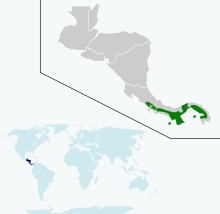Snowy-bellied hummingbird
| Snowy-bellied hummingbird | |
|---|---|

| |

| |
| In Mount Totumas cloud forest, Panama Images show how 'color' of feathers changes with lighting | |
| Scientific classification | |
| Domain: | Eukaryota |
| Kingdom: | Animalia |
| Phylum: | Chordata |
| Class: | Aves |
| Clade: | Strisores |
| Order: | Apodiformes |
| Family: | Trochilidae |
| Genus: | Saucerottia |
| Species: | S. edward
|
| Binomial name | |
| Saucerottia edward | |

| |
| Range of S. edward | |
| Synonyms | |
|
Amazilia edward[3] | |
The snowy-bellied hummingbird (Saucerottia edward), also known as snowy-breasted hummingbird, is a species of hummingbird in the "emeralds", tribe Trochilini of subfamily Trochilinae. It is found in mostly in Costa Rica and Panama with a few records in Colombia.[4][3][5]
Taxonomy and systematics
The snowy-bellied hummingbird was formerly placed in the
The snowy-bellied hummingbird has these four subspecies:[4]
- S. e. niveoventer (Gould, 1851)
- S. e. edward (Delattre & Bourcier, 1846)
- S. e. collata (Wetmore, 1952)
- S. e. margaritarum Griscom, 1927
Subspecies S. e. niveoventer has been suggested as a separate species based on the color of its tail but this treatment has not gained acceptance.[10]
Description
The snowy-bellied hummingbird is 8 to 11 cm (3.1 to 4.3 in) long. Males weigh 5 to 5.4 g (0.18 to 0.19 oz) and females 4.3 to 5.2 g (0.15 to 0.18 oz). Both sexes of all subspecies have a straight blackish bill whose
Subspecies S. e. niveoventer is slightly larger than the nominate and its tail is bluish black to purplish black. S. e. collata has less contrast between the green and copper of the back than the nominate and brownish undertail coverts. S. e. margaritarum has paler undertail coverts than the nominate and a bronze to bronze-green tail.[10]
Distribution and habitat
The subspecies of snowy-bellied hummingbird are found thus:[4][10]
- S. e. niveoventer, from southwestern Costa Rica into western and central Panama including Coiba Island
- S. e. edward, Panama from the Canal Zone east into Darién Province with at least one record in northwestern Colombia's Chocó Department[11]
- S. e. collata, central Panama
- S. e. margaritarum, Panama: southwestern Darién, the Pearl Islands, and other islands in the Gulf of Panama
The snowy-bellied hummingbird inhabits different landscapes across its distribution. In Costa Rica and western Panama it favors semi-open areas such as savanna, scrublands with scattered trees, edges and clearings of
Behavior
Movement
The snowy-bellied hummingbird appears to be mostly sedentary. It does make local movements from arid areas in the wet season to more humid ones in the dry season. It also appears to move in response to availability of flowers.[10]
Feeding
The snowy-bellied hummingbird forages for nectar at a wide variety of native and introduced plants, shrubs, and trees. It usually feeds between about 3 and 6 m (10 and 20 ft) of the ground. It sometimes defends feeding territories. In addition to nectar, it feeds on small arthropods captured by hawking from a perch and by gleaning from foliage.[10]
Breeding
The western populations of snowy-bellied hummingbird breed between September and January with most nesting in December and January. The nest is a cup of downy fibers with lichens and moss on the outside. It is typically placed on a branch or in a fork of a bush or small tree up to 9 m (30 ft) above the ground. The female incubates the clutch of two eggs; the incubation period and time to fledging are unknown.[10]
Vocalization
The snowy-bellied hummingbird's song is "a soft 'bebeebee, d’beebee' or 'tseer tir tir'." It also makes "tip" or "tsip" calls.[10]
Status
The
References
- ^ a b BirdLife International (2021). "Snowy-bellied Hummingbird Amazilia edward". IUCN Red List of Threatened Species. 2021. Retrieved 7 September 2022.
- ^ "Appendices | CITES". cites.org. Retrieved 14 January 2022.
- ^ a b c HBW and BirdLife International (2021) Handbook of the Birds of the World and BirdLife International digital checklist of the birds of the world. Version 6. Available at: http://datazone.birdlife.org/userfiles/file/Species/Taxonomy/HBW-BirdLife_Checklist_v6_Dec21.zip retrieved 7 August 2022
- ^ a b c d Gill, F.; Donsker, D.; Rasmussen, P., eds. (August 2022). "Hummingbirds". IOC World Bird List. v 12.2. Retrieved 9 August 2022.
- ^ Remsen, J. V., Jr., J. I. Areta, E. Bonaccorso, S. Claramunt, A. Jaramillo, D. F. Lane, J. F. Pacheco, M. B. Robbins, F. G. Stiles, and K. J. Zimmer. Version 24 July 2022. A classification of the bird species of South America. American Ornithological Society. https://www.museum.lsu.edu/~Remsen/SACCBaseline.htm retrieved 24 July 2022
- PMID 24704078.
- PMID 29245495.
- ^ "Check-list of North and Middle American Birds". American Ornithological Society. August 2022. Retrieved 9 August 2022.
- ^ Clements, J. F., T. S. Schulenberg, M. J. Iliff, S. M. Billerman, T. A. Fredericks, J. A. Gerbracht, D. Lepage, B. L. Sullivan, and C. L. Wood. 2021. The eBird/Clements checklist of Birds of the World: v2021. Downloaded from https://www.birds.cornell.edu/clementschecklist/download/ Retrieved 25 August 2021
- ^ a b c d e f g h i j Weller, A.A. (2021). Snowy-bellied Hummingbird (Saucerottia edward), version 1.1. In Birds of the World (J. del Hoyo, A. Elliott, J. Sargatal, D. A. Christie, and E. de Juana, Editors). Cornell Lab of Ornithology, Ithaca, NY, USA. https://doi.org/10.2173/bow.snbhum1.01.1 retrieved 7 September 2022
- ^ Colorado, G.J.; Pulgarín, P.C. (2003). "Snowy-bellied Hummingbird Saucerottia edward, new to Colombia and South America". Cotinga. 20: 99–101.
External links
- Snowy-bellied hummingbird photo gallery at VIREO (Drexel University)
Additional reading
Angehr, George R.; Dean, Robert (2010). The Birds of Panama. Ithaca: Zona Tropical/Comstock/Cornell University Press. p. 150.


